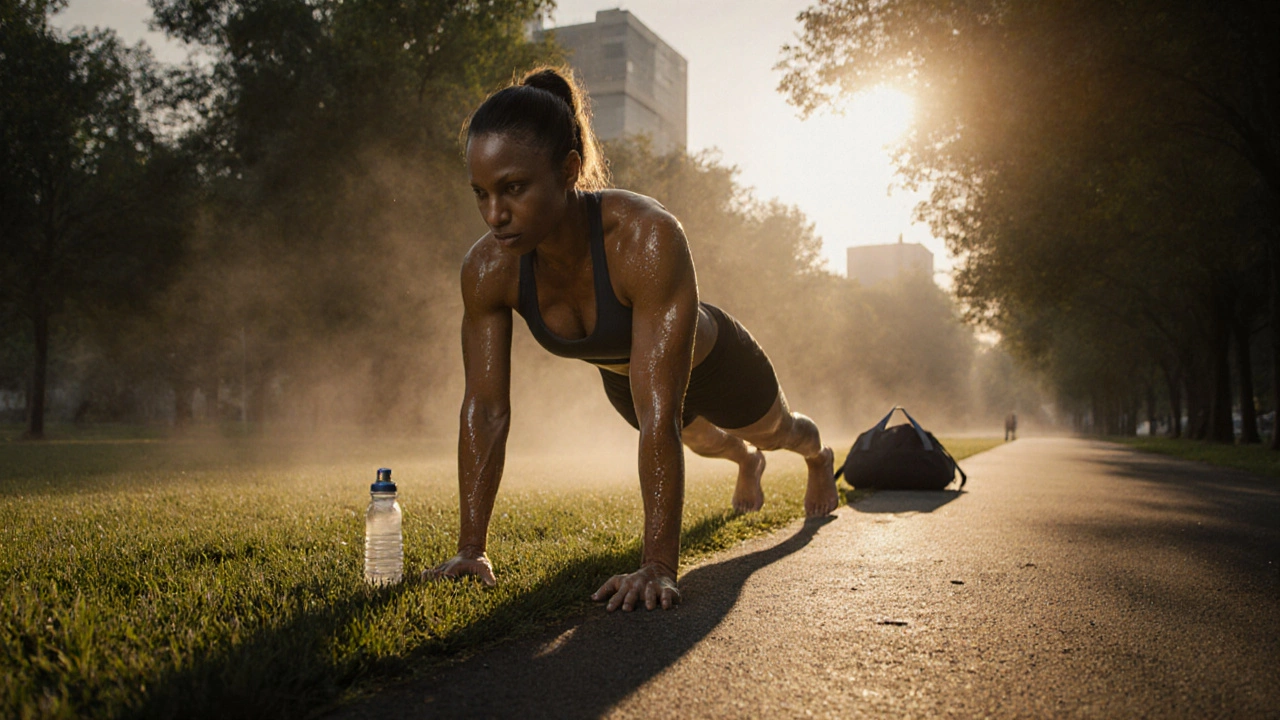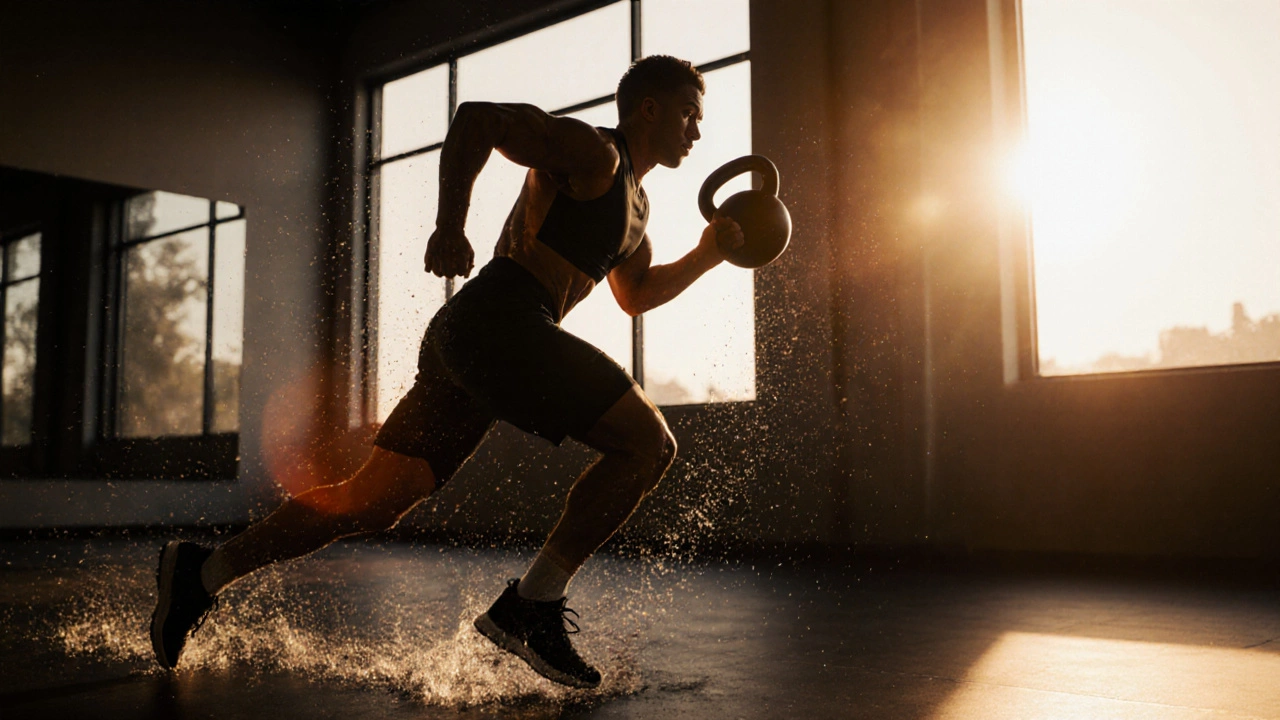
Want to get the most out of your HIIT workouts? It’s not just about how hard you push-it’s about when you push. People swear by morning HIIT. Others say evening is when they crush it. But what does the science actually say? And more importantly, what works for your body, your schedule, and your goals?
Why Timing Matters More Than You Think
HIIT isn’t just cardio. It’s a full-system stress test. Your heart, your muscles, your hormones-they all react differently depending on the time of day. Doing HIIT at the wrong time can leave you drained, sore, or even sabotaging your sleep. Do it at the right time, and you’ll recover faster, burn more fat, and feel stronger all day.
Studies from the Journal of Strength and Conditioning Research show that muscle strength and power peak in the late afternoon, between 4 PM and 7 PM. That’s when your body temperature is highest, your muscles are more elastic, and your reaction time is sharpest. For explosive movements like burpees, jump squats, and kettlebell swings, that’s a real advantage.
Morning HIIT: The Early Advantage
Maybe you’re a morning person. Maybe you hate the idea of working out after a long day. Morning HIIT has its own powerful perks.
First, it sets the tone. A 20-minute HIIT session before breakfast triggers fat burning. When you train fasted, your body taps into stored fat for fuel instead of recently eaten carbs. A 2023 study in the British Journal of Nutrition found that fasted morning HIIT led to 20% more fat oxidation over 24 hours compared to fed sessions.
Second, consistency skyrockets. People who work out in the morning are 80% more likely to stick with their routine long-term, according to data from the American College of Sports Medicine. Once it’s done, it’s done. No excuses. No last-minute cancellations.
But there’s a catch. Your body isn’t warmed up. Core temperature is low. Ligaments are stiff. That means injury risk goes up if you skip the dynamic warm-up. Five minutes of leg swings, arm circles, and light jogging isn’t optional-it’s essential.
Evening HIIT: Peak Performance Mode
If your goal is to push harder, lift more, or sprint faster, evening might be your sweet spot. Between 4 PM and 7 PM, your body is primed. Testosterone and cortisol levels are in the ideal balance. Your nervous system is firing on all cylinders.
One 2024 study tracked 120 people doing HIIT three times a week. Those who trained in the evening improved their VO2 max by 12% more than those who trained in the morning. Their sprint times dropped faster. Their recovery was smoother.
And let’s talk about stress relief. After a long day, HIIT isn’t just exercise-it’s therapy. The endorphin rush clears mental fog. It helps you shut off the noise. Many people report sleeping better after an evening session, not worse.
Wait-sleep better? But doesn’t exercise raise your heart rate? Yes. But the key is timing. Finish your HIIT at least 90 minutes before bed. That gives your body time to cool down, your cortisol to drop, and your parasympathetic nervous system to kick in. Do it too late-say, 10 PM-and you might lie awake staring at the ceiling.
What About Lunchtime HIIT?
Lunchtime workouts are the forgotten middle child. But they’re not useless. If you work a 9-to-5, squeezing in a 20-minute HIIT session between meetings can reset your brain. It boosts focus for the rest of the day.
A 2022 study from the University of Bristol found that employees who did a 20-minute HIIT break at noon reported 30% higher productivity in the afternoon. Their mood improved. Their energy didn’t crash.
The downside? You need to eat before you work out. Training right after lunch can cause nausea. Wait at least 60 to 90 minutes after eating. Stick to light, easy-to-digest carbs-like a banana or a slice of toast-before you start.

Best Time for Weight Loss?
If your main goal is fat loss, the answer is simple: do it when you’ll actually show up.
But if you’re trying to pick the most effective time, go with fasted morning HIIT. No food in your system means your body pulls from fat stores. Combine that with a low-carb diet, and you’re maximizing fat oxidation.
Still, don’t ignore the evening option. People who train later often burn more total calories because they push harder. More intensity = more calories. More calories burned = more fat loss over time.
Real talk: One person’s 15-minute morning HIIT done consistently beats another person’s 30-minute evening session done once a week. Consistency beats perfection every time.
Best Time for Building Muscle?
HIIT isn’t just for cardio. High-intensity circuits with bodyweight squats, push-ups, and pull-ups build lean muscle too.
For muscle growth, evening wins. Your muscles are warmer. Your strength is higher. Your central nervous system is ready to handle heavy, explosive movements. That means better form, more reps, and more micro-tears in the muscle fibers-exactly what triggers growth.
Plus, protein synthesis peaks 24 to 48 hours after training. If you train in the evening, you’re sleeping through the peak recovery window. Your body repairs and rebuilds while you rest.
What About Your Circadian Rhythm?
Not everyone is built the same. Some people are larks-early risers. Others are owls-night owls. Trying to force yourself into a schedule that goes against your biology is a recipe for burnout.
Ask yourself:
- Do you feel energized at 6 AM or drained?
- Do you hit a wall after lunch?
- When do you naturally feel most alert?
Match your HIIT time to your natural rhythm. If you’re a night person, forcing yourself into morning workouts will make you resent the routine. If you’re a morning person, evening workouts might leave you wired and unable to sleep.
Your body knows when it’s ready. Listen to it.

Quick Decision Guide: When Should You Do HIIT?
Still unsure? Here’s a simple flow:
- Want to lose fat fast? Try fasted morning HIIT (6-8 AM), 3-4 times a week. Eat a protein-rich breakfast after.
- Want to get stronger or faster? Go evening (5-7 PM). You’ll hit higher intensity and recover better.
- Need to beat afternoon slumps? Lunchtime HIIT (12:30-1:30 PM). Keep it light and finish 90 minutes before dinner.
- Struggle with consistency? Pick the time that fits your life easiest. Even 10 minutes, three times a week, beats zero.
Common Mistakes to Avoid
Even the best timing won’t help if you make these errors:
- Skipping warm-up. Cold muscles = injury risk. Always do 5-10 minutes of movement prep.
- Doing HIIT every day. Your body needs recovery. Stick to 3-4 sessions per week max.
- Training too close to bedtime. Finish at least 90 minutes before sleep to avoid disrupting melatonin.
- Not eating enough afterward. HIIT burns fuel. Refuel with protein and carbs within 45 minutes.
- Comparing yourself to others. Your best time isn’t someone else’s. Your schedule, your rhythm, your results.
Final Answer: There’s No One Right Time
The best time for HIIT is the time you’ll actually do it. Science gives you options. But consistency gives you results.
If you’re just starting out, try morning HIIT for a week. See how you feel. Then try evening for a week. Track your energy, your sleep, your performance. You’ll know what works for you.
Don’t overthink it. Put on your shoes. Move. Show up. That’s the real secret.
Is it better to do HIIT in the morning or evening for fat loss?
Fasted morning HIIT burns more fat during the workout because your body uses stored fat for fuel. But evening HIIT often leads to higher intensity and more total calories burned. For fat loss, consistency matters more than timing. Do it when you’ll stick with it.
Can I do HIIT twice a day?
It’s not recommended for most people. HIIT is high stress on your body. Doing it twice a day increases injury risk and can lead to burnout. Stick to 3-4 sessions per week, with rest or low-intensity movement on other days.
Should I eat before morning HIIT?
For fat loss, you can do it fasted. But if you feel dizzy or weak, have a small snack like a banana or a spoon of peanut butter 30 minutes before. Your performance will improve, and you’ll avoid muscle breakdown.
Does HIIT at night ruin sleep?
Not if you finish at least 90 minutes before bed. Your body needs time to cool down and lower cortisol. If you’re still buzzing at 11 PM, move your workout earlier. Most people sleep better after evening HIIT because it reduces stress.
How long should a HIIT session last?
20 to 30 minutes is ideal. That includes warm-up and cool-down. The actual high-intensity intervals should be 15-20 minutes total. More than 30 minutes isn’t necessarily better-it just increases risk of overtraining.
